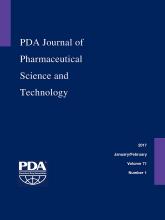Abstract
Environmental monitoring and aseptic process simulations represent an integral part of the microbiological quality control system of sterile pharmaceutical products manufacturing operations. However, guidance documents and manufacturers practices differ regarding recommendations for incubation time and incubation temperature, and, consequently, the environmental monitoring and aseptic process simulation incubation strategy should be supported by validation data. To avoid any bias coming from in vitro studies or from single-site manufacturing in situ studies, we performed a collaborative study at four manufacturing sites with four samples at each location. The environmental monitoring study was performed with tryptic soy agar settle plates and contact plates, and the aseptic process simulation study was performed with tryptic soy broth and thioglycolate broth. The highest recovery rate was obtained with settle plates (97.7%) followed by contact plates (65.4%) and was less than 20% for liquid media (tryptic soy broth 19% and thioglycolate broth 17%). Gram-positive cocci and non-spore-forming Gram-positive rods were largely predominant with more than 95% of growth and recovered best at 32.5 °C. The highest recovery of molds was obtained at 22.5 °C alone or as the first incubation temperature. Strict anaerobes were not recovered. At the end of the five days of incubation no significant statistical difference was obtained between the four conditions. Based on these data a single incubation temperature at 32.5 °C could be recommended for these four manufacturing sites for both environmental monitoring and aseptic process simulation, and a second plate could be used, periodically incubated at 22.5 °C. Similar studies should be considered for all manufacturing facilities in order to determine the optimal incubation temperature regime for both viable environmental monitoring and aseptic process simulation.
LAY ABSTRACT: Microbiological environmental monitoring and aseptic process simulation confirm that pharmaceutical cleanrooms are in an appropriate hygienic condition for manufacturing of sterile drug products. Guidance documents from different health authorities or expert groups differ regarding recommendation of the applied incubation time and incubation temperature, leading to variable manufacturers practices. Some recent publications have demonstrated that laboratory studies are not relevant to determine the best incubation regime and that in situ manufacturing site studies should be used. To solve any possible bias coming from laboratory studies or single-site in situ studies, we conducted a multicenter study at four manufacturing sites with a significant amount of real environmental monitoring samples collected directly from the environment in pharmaceutical production during manufacturing operations with four solid and liquid nutrient media. These samples were then incubated under four different conditions suggested in the guidance documents. We believe that the results of our multicenter study confirming recent other single-site in situ studies could be the basis of the strategy to determine the best incubation regime for both viable environmental monitoring and aseptic process simulation in any manufacturing facility.
- Environmental monitoring
- Aseptic process simulation
- Primary isolation of microorganisms
- Incubation conditions
- Incubation temperature
- Microbiology
- Cleanroom
- © PDA, Inc. 2017
PDA members receive access to all articles published in the current year and previous volume year. Institutional subscribers received access to all content. Log in below to receive access to this article if you are either of these.
If you are neither or you are a PDA member trying to access an article outside of your membership license, then you must purchase access to this article (below). If you do not have a username or password for JPST, you will be required to create an account prior to purchasing.
Full issue PDFs are for PDA members only.
Note to pda.org users
The PDA and PDA bookstore websites (www.pda.org and www.pda.org/bookstore) are separate websites from the PDA JPST website. When you first join PDA, your initial UserID and Password are sent to HighWirePress to create your PDA JPST account. Subsequent UserrID and Password changes required at the PDA websites will not pass on to PDA JPST and vice versa. If you forget your PDA JPST UserID and/or Password, you can request help to retrieve UserID and reset Password below.






